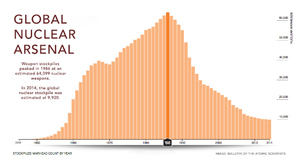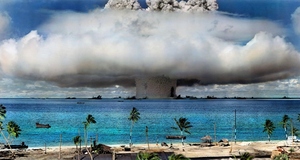What to do With Nuclear Waste? The Rise and Fall of Yucca Mountain
By
2010, Vol. 2 No. 03 | pg. 1/2 | »
KEYWORDS:
With over 20% of United States power production being of a nuclear nature, and all of this nuclear production generating high-level nuclear waste, the US has already accumulated large quantities of volatile nuclear waste and will only have more in the future (Schneider, 2009). Currently, there are few options for dealing with nuclear waste. Although research and development of storage/remediation methods is ongoing, current waste that has accumulated is stored in sealed casks mostly on-site at the plants at which they are generated. This scattering of radioactive waste throughout the country at ground level is seen as a liability for natural disasters and terrorist actions. One proposed solution for the management of nuclear waste is through underground sequestration in a major Department of Energy run facility. This would collect all of the nation’s accrued nuclear wastes in one safe location underground to allow the waste to decay over time in a controlled environment isolated from environmental factors that could undermine their containment. The sequestration of nuclear waste underground demands an arid environment that has a very deep water table, as to prevent groundwater contamination and seepage. The proposed Yucca Mountain, Nevada site fit this bill perfectly with what has been described as “several hundred meter-thick unsaturated zones common to the arid and semiarid Southwest U.SA.” (Winograd, 2008). First investigated in 1978, Yucca Mountain, Nevada has been studied for the last 31 years as a possible nuclear waste repository for the US nuclear power generation program (Warren, 2005). Throughout the years of its proposal and investigation, the issue of whether or not to locate a nuclear waste facility of such magnitude at a site in our own Nevada desert has been hotly debated and contested. If it were to come to fruition, The Yucca Mountain Nuclear Waste Repository would be the first long-term storage facility in the US for high-level nuclear waste.Beginning with the Waste Policy Act of 1982, three different sites in the US were identified as possible sites to locate and process the long-term storage of high-level nuclear waste. Each was required to be studied in depth for feasibility, hydrology, geochemistry, and paleoclimatology (Winograd, 2008). From these studies, the US Department of Energy was delegated the task of designing and implementing such a facility. Based on the information presented to the secretary of energy, one specific site would be chosen with the approval of the secretary (Warren, 2005). In 1987, the Waste Policy Act was amended to specify Yucca Mountain, Nevada as the chosen site based on its advantageous attributes for such a facility. Additionally, in a move that many would call unwise, the amendment nullified the previous requirement of the act for all three sites to be studied in depth. This left Yucca Mountain with a virtually clear path as it was the only site studied in great detail, and was determined to be feasible (Winograd, 2008). In spring 2002, President George W. Bush officially endorsed the Yucca Mountain site as the US’s answer for a mounting nuclear waste problem; an answer that he said would last 10,000 years (Forest, 2002). Pre-construction, the facility stands with an “Exploratory Studies Facility.” This facility exists a hundred stories underground, where the proposed tunnels housing waste would be located. 70,000 tons of waste, to be specific, mostly uranium from power production and plutonium from weapons operations (Forest, 2002). This waste is to be stored in casks composed of stainless steel and “a synthetic blend of corrosion-resistant materials called Alloy 22” (Forest, 2002). Naturally, the proposal of such a site has faced many logistical challenges. Some of these included the possibility of groundwater penetration, earthquake vulnerability, and the sheer degree of time that the facility would need to be operational to allow the waste to decay. Many have claimed that the EPA’s “compliance standard” that required the containers to effectively sequester the waste for 10,000 years are far too short, with real requirements being in the hundreds of thousands. In fact, in a ruling by the US Court of Appeals, a panel of judges determined that the EPA “disregarded recommendations from a 1995 National Academy of Sciences study that the standard be hundreds of thousands of years, or longer” (Slattery, 2004). This is supported by a 1998 study conducted by the Institute of Energy and Environmental research, concluding that because of pockets of moisture that were present in the Yucca Mountain, which had come from beneath, the site had flooded in the past (Bloomfield, 2005). If it had flooded in the past, it could very well flood in the future, possibly compromising the containment systems separating the noxious nuclear wastes from the outside environment. The most influential obstacle that the proposed Yucca Mountain site has faced, however, has been funding. Given the recent economic downturn and massive government deficits, the US Federal Government simply cannot afford to fund such a facility in its given situation. With troops deployed in the Middle East, an already severely swelled annual budget, failing healthcare systems, and rising unemployment of great national concern, the government is forced to devote its limited resources elsewhere in the present state of the nation. Additionally, it really is not clear that sequestration and long-term storage of nuclear waste is the most cost-effective option. The original thinking has been that because nuclear waste decays over time, delaying reprocessing of these wastes as long as we can, would be most cost effective. This stems from the admittedly logical thinking that, given that the waste slowly decays over time, the longer we wait to process it the less radioactive it will be when we actually do process it, making it cheaper to process in the long run. When reviewing scientific studies on the matter, however, it becomes clear that this idea simply is not true. Because high-level nuclear waste takes so long to decay, reprocessing in the future will not be discounted enough to cover the cost of storage for such a long period of time. In fact, the overall cost of long-term storage and then reprocessing is actually 2.5% higher than immediate reprocessing (Schneider, 2009).Continued on Next Page » Suggested Reading from Inquiries Journal
Inquiries Journal provides undergraduate and graduate students around the world a platform for the wide dissemination of academic work over a range of core disciplines. Representing the work of students from hundreds of institutions around the globe, Inquiries Journal's large database of academic articles is completely free. Learn more | Blog | Submit Latest in Environmental Studies |


















